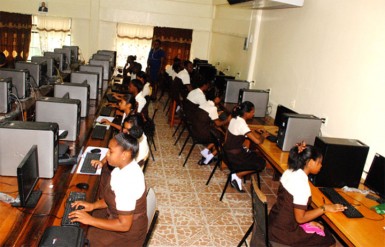Guyana ranks 93rd on The World Economic Forum’s Network Readiness Index in its 2015 Global Information Technology Report. The latest ranking points to a slip from 88th which the country recorded last year.
Of the list of 143 countries ranked by the World Economic Forum only Suriname and Haiti amongst Caribbean Community (Caricom) countries, occupying 113th and 137th places, respectively, on the table, are ranked below Guyana.
Regarded as the most network ready territory in Caricom, Barbados is the highest ranked regional territory at 39th, sixteen places above the 55th place which it occupied in 2014, while the ranking of the oil-rich Trinidad and Tobago dropped one place to 70th from its position last year. This year, Jamaica is ranked 82nd, four places above its 2014 ranking of 86th.

The World Economic Forum’s criteria for determining network readiness are measured by four main sub-indexes and 53 individual indicators. Under the environmental sub-index the political and regulatory environment pillar measures “the extent to which a country’s political and regulatory environments facilitate ICT penetration and the development of business incentives. It does so by measuring the extent of intellectual property rights, protection, prevalence of software piracy, the efficiency and independence of the judiciary, the efficiency of the law-making process and the overall quality of regulations pertaining to ICT‘s.
The business and innovation environment pillar gauges the extent to which the business environment supports entrepreneurship by taking account of measures like red tape, the ease of starting a business and taxation. It also measures the conditions that allow innovation to flourish by including indicators on the overall availability of technology, the intensity of competition, the demand conditions for innovative products and the availability of venture capital for funding innovation-related projects.
The report’s infrastructure pillar criteria seeks to capture the state of countries’ ICT
infrastructure as well as infrastructure that matters for ICT development while the affordability pillar assesses the affordability of ICT in a country through measures of mobile telephony usage costs and broadcast internet subscription.
The individual user pillar, meanwhile, measures the level of diffusion among the country’s population while the economic and social impacts’ pillars measures the effects of ICT in the economy and societal progress resulting from the use of ICT, respectively.
Meanwhile the Report says that the spread of ICT has had a wide societal effect especially on less-privileged segments of society pointing specifically to the fact that “farmers in developing countries have benefited from new ICT services such as real-time information about commodity prices and weather and from the ease of money transfers.”
The report also alludes to what it says has been “the increased effectiveness of governments” as a result of their ability to provide “citizen-centric online services and to involve citizens in governance.”
On the other hand the report asserts that these same results reveal it is mostly the rich countries that have been benefiting from the ICT revolution. “Paradoxically, ICTs have opened up new digital divides. Although internet access is expanding, 61 per cent of the world’s population remain unconnected. The distribution of high-speed broadband and the use of mobile applications and advanced data services vary widely across and within economies,” the report says.




